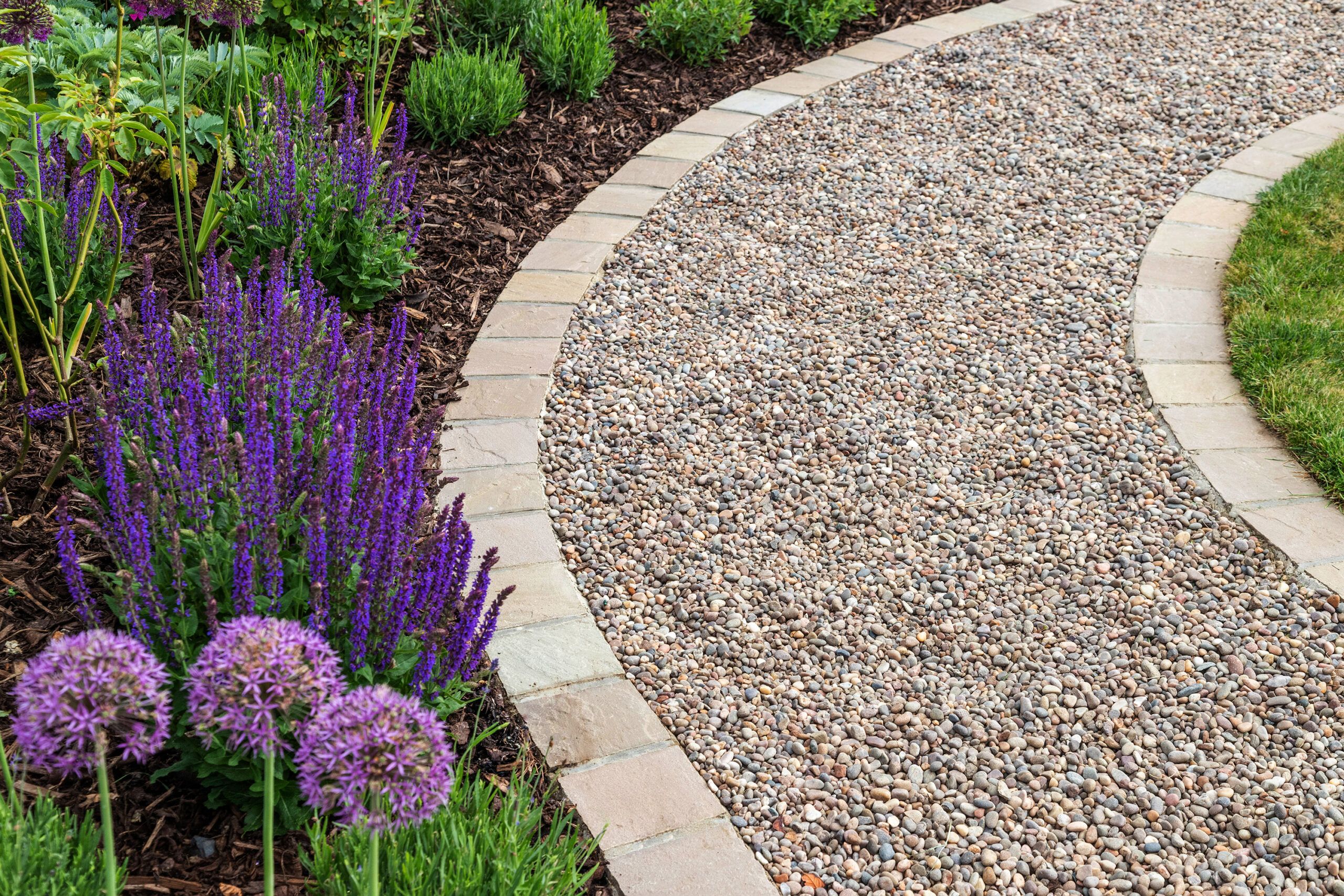Project details
Skill
Cost
Estimated Time
The best landscapes guide visitors with paths—well-defined walkways that say, “Hey, follow this trail,” and, gently, “Keep off the grass.”
Sure, you could spend several days and many dollars putting in a walkway made of cobbles or bluestone, but a simple gravel trail won’t break your back—or budget.
Gravel is a traditional path material found in formal gardens throughout Europe and Asia, and takes little skill to install. Below, This Old House’s Mark Powers demonstrates how to install natural-looking, foliage-free walkway in an afternoon.
Gravel Path Overview
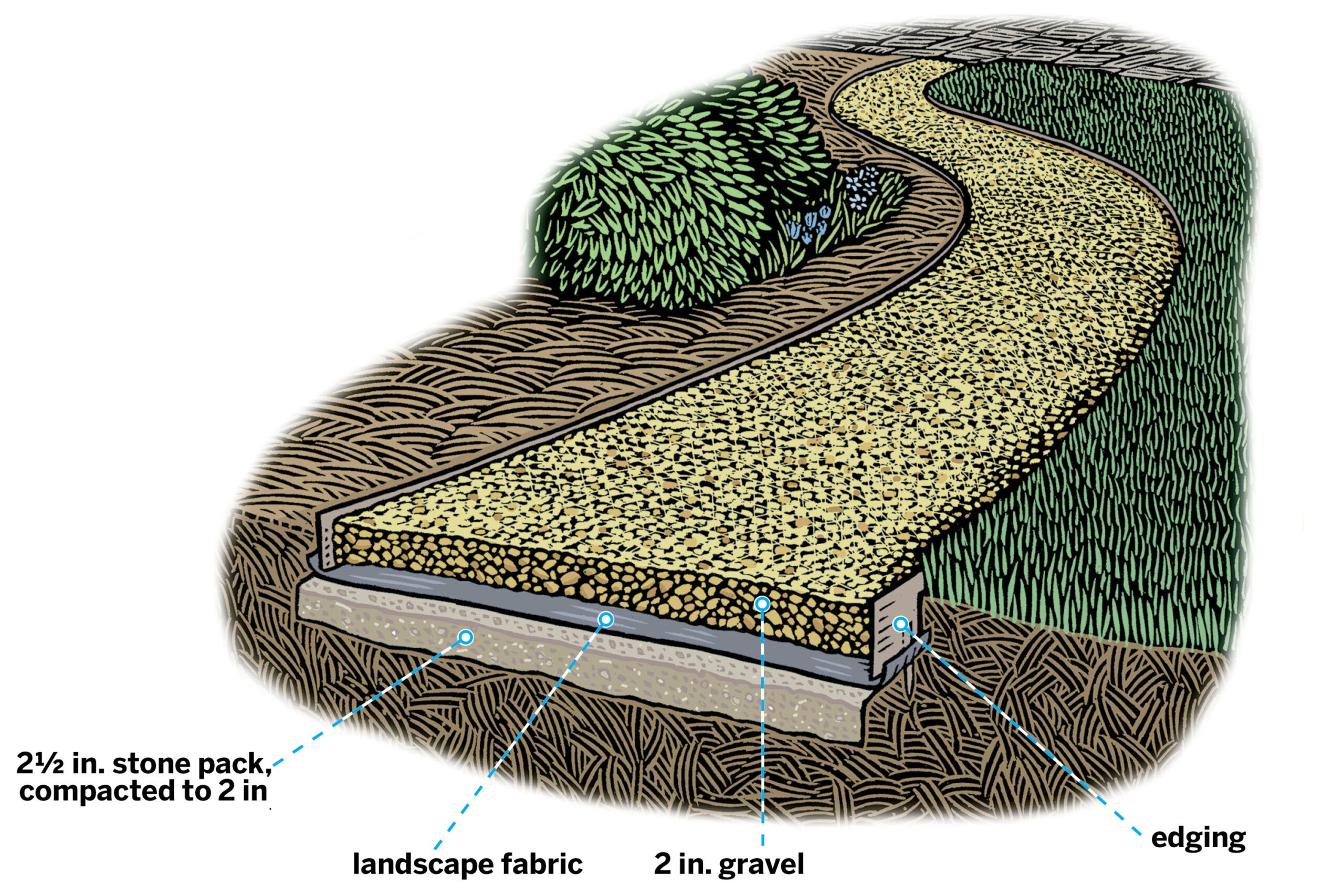
Gravel paths are easy to install because they aren’t set very deep. You only have to dig down a few inches to make room for the pebbles—even in cold-weather climates. Because the tiny stones move fluidly, winter’s freezes and thaws won’t heave and crack the surface in the same way they would with a rigid material like stones or pavers.
A gravel path can also take on many shapes. “You can make a twisty, curvy, organic walk. And you don’t have to worry about cutting the stones,” says Roger Cook, This Old House landscape contractor.
Still, to give the path structure and stability, it must have a compact base. In zones with hard clay, that can be the soil itself. But in most areas, especially where the soil is sandy, you’ll need to create a base of tamped-down stone pack, which is a mix of 3/4-inch stones and stone dust. A lining of landscape fabric over the base will keep weeds from growing up through the path.
The gravel, being so movable, also needs an edge to contain it. Galvanized steel is a durable and traditional choice and also malleable enough for curves. But you can also use pressure-treated wood, cedar, bricks, cobblestones, or even plastic edging. Just be sure the gravel stops about 1/2 inch short of the edging’s top—which should be flush with surrounding plant beds and lawn—or the gravel will spill over. You can also make the path as wide as you like, though 3–4 feet is standard.
What you put down between the edging is also a matter of choice. Colonial Americans crushed the cast-off shells from their oyster feasts to line their garden paths; these days, you’re likely to see crushed granite or lava stone as often as gravel.
Tools You’ll Need To Lay a Gravel Path
 Square shovel
Square shovel Tamper
Tamper
How To Lay a Gravel Path
Below are the steps for laying your gravel pathway.
Step 1: Dig Out the Path’s Shape
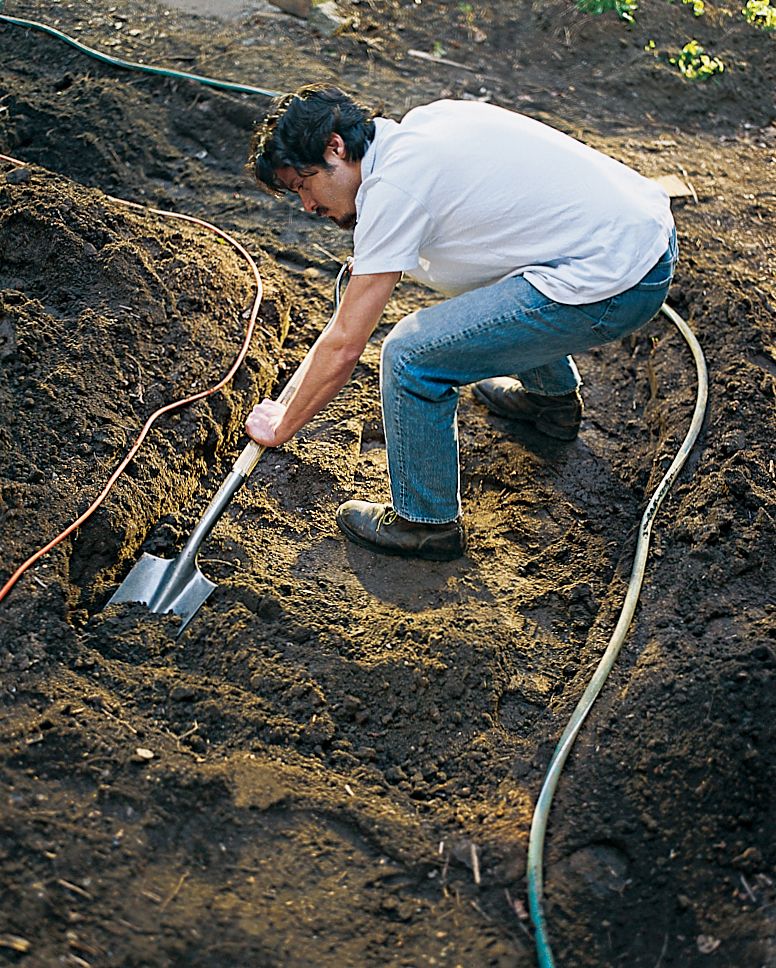
Start by marking the location and shape of your path with a garden hose, length of rope or spray paint. If using spray paint, buy line-marking paint, which allows you to easily spray lines while holding the can upside down.
Using a square-edged spade, remove the soil within that border to a depth of 4 inches.
Step 2: Form the Trench
When digging the trench, use the square-edged spade to straighten the sides and make the bottom as even as possible. Occasionally, check the depth of the trench with a tape measure as you go. Next, smooth the bottom of the trench with a steel rake, then compact the soil with a hand tamper.
Tip: When digging, place the excavated soil onto a tarp to make it easier to remove.
Step 3: Add Crushed Stone
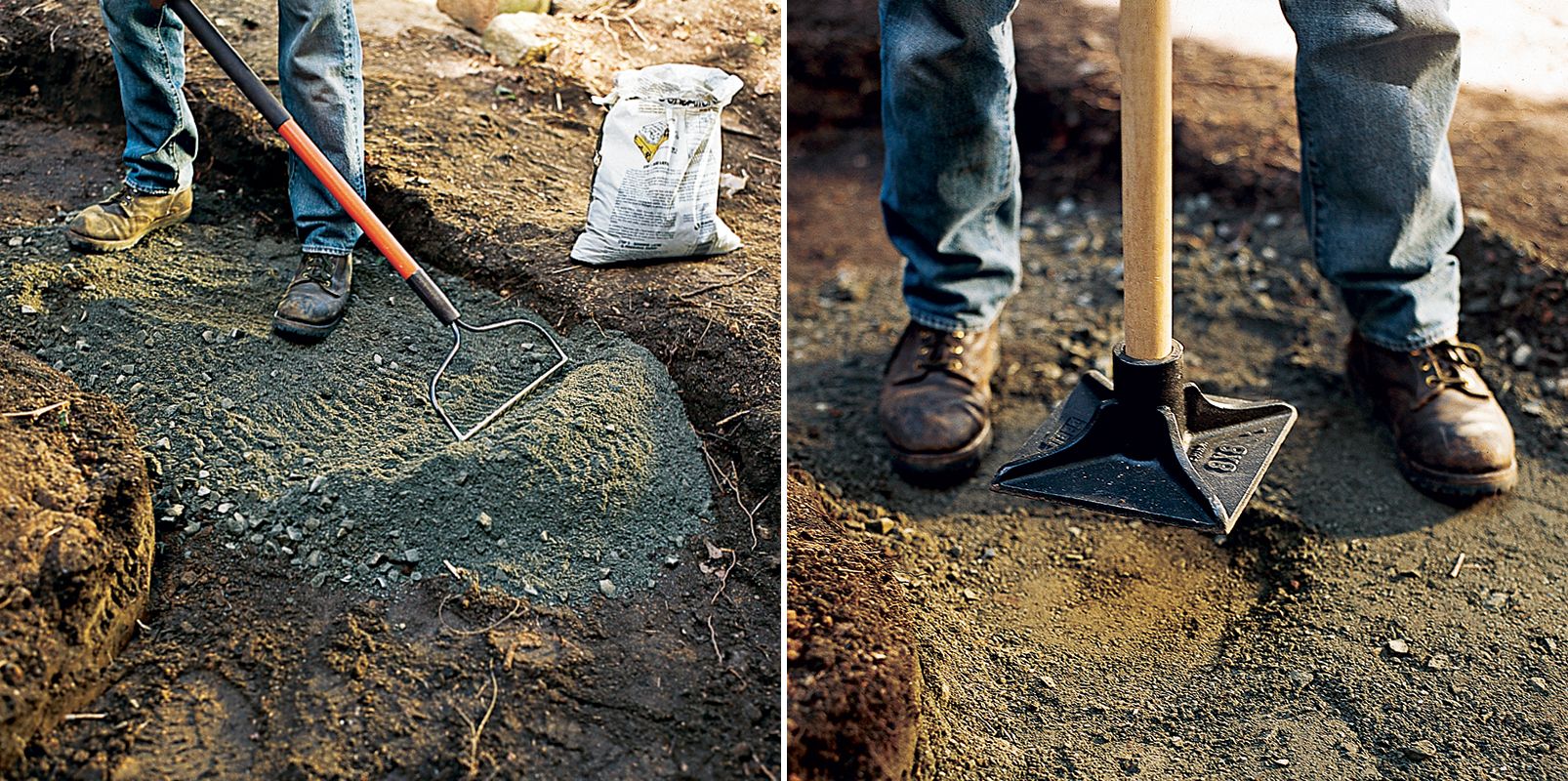
After smoothing and compacting the soil in the bottom of the trench, line the trench with about 2 1/2 inches of crushed stone pack. Rake the pack to level its surface.
Step 4: Compact the Stone Base
Dampen the stone pack by spraying it lightly with a garden hose or watering can. Then, use a 6- or 8-inch-square hand tamper to pound the stone pack into a smooth, hard surface. Dampening the crushed stone first keeps down dust and helps with compaction.
Step 5: Lay Down the Landscape Fabric
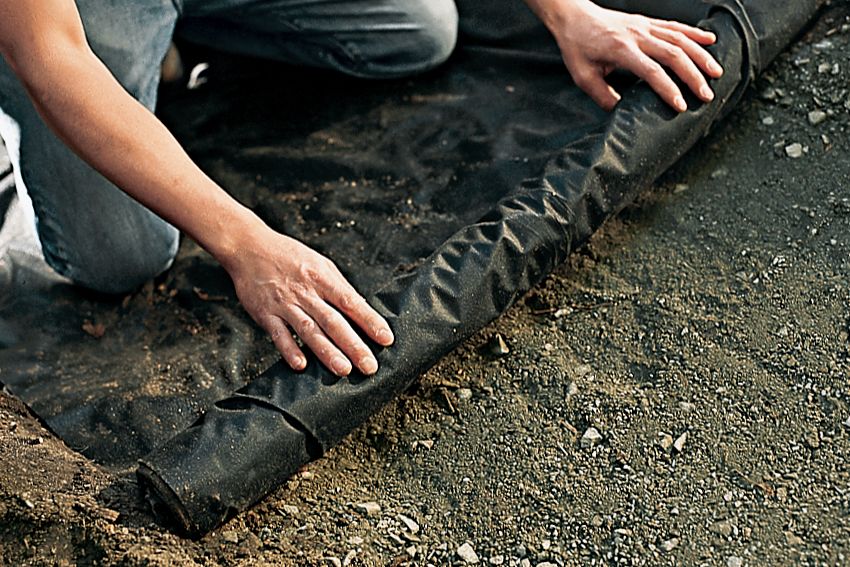
Roll out a layer of landscape fabric over the compacted stone pack, shiny side up.
To contour the fabric around curves, make relief cuts along both the outside and inside edges. On the inside of the curve, overlap the fabric at the cuts. On the outside, allow the fabric to open up at the cuts.
Tip: Use spikes or pins to hold the fabric taut so it won’t bunch up through the finished layer of gravel. You can also let the edging do double duty by installing it over the fabric and letting its spikes punch through.
Step 6: Install the Edging

Make a template to hold the two parallel lengths of edging lined up at an even distance apart. We recommend taking a scrap of 2×3 and cutting into it two grooves spaced 3 feet apart. Make sure the cuts are wide enough and deep enough to slide over the galvanized steel edging.
Join together two lengths of edging following the manufacturer’s instructions. Line the inside of the trench with the edging pieces, resting them on top of the landscape fabric.
Step 7: Tap Down the Edging
Slide the 2×3 template onto each piece of edging across the first section of the path. Using a wood block and a hammer, tap the edging into the ground, through the fabric.
As you hammer the edging into the ground, using a scrap-wood tapping block, check to make sure it’s going in perfectly straight and not leaning into the trench. Also, never hammer directly onto the steel edging, as this may damage its protective zinc-galvanized coating and lead to rusting. Once all the edging is installed, backfill along the backside of the edging.
Step 8: Fill the Path With Gravel
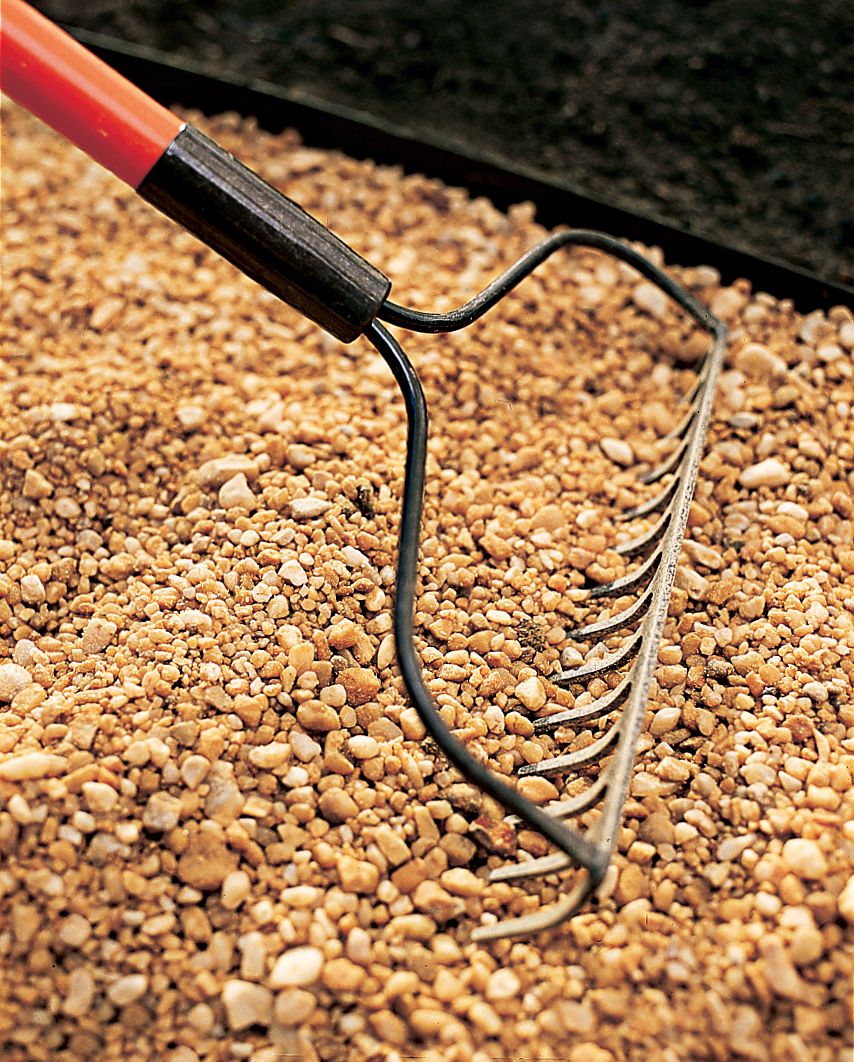
Pour out enough gravel to come about 1/2 inch shy of the top of the edging. Rake the gravel out evenly, making sure none of the landscape fabric shows through.
Landscape around the path with flowerbeds or sod. Maintain the path by occasionally raking it smooth and refilling it with more gravel, as necessary.
Comparing Gravel Paths To Other Materials
While gravel paths offer many benefits, it’s worth comparing them to other popular path materials so you can make an informed decision.
- Brick patios: Provide a classic look but are more labor-intensive to install.
- Concrete: More durable but less permeable and often more expensive.
- Pavers: Offer a wide range of designs but require more skill to install.
- Mulch: Very affordable but needs frequent replenishment.
If you want a compromise between gravel and more permanent options, consider learning how to lay a stone patio, which provides a durable yet natural-looking surface.
Cost-Saving Tips for Your Gravel Path Project
Creating a budget-friendly gravel path doesn’t mean compromising on quality. Here are some tips to help you save money on your project.
- Choose locally sourced gravel to reduce transportation costs.
- Compare prices from multiple suppliers for materials like gravel and edging.
- Consider using recycled materials for edging, such as reclaimed bricks or timber.
- Rent tools instead of buying them if you don’t plan to use them frequently.
- Tackle the project yourself instead of hiring professionals.
Enhance Your Gravel Path with Landscaping
A well-designed gravel path can be further enhanced with thoughtful landscaping. Here are some ideas for complementary plants and lighting options to elevate your path’s visual appeal.
Complementary Plants for Path Borders
Choosing the right plants to border your gravel path can create a cohesive and inviting landscape. Consider these options:
- Flowering perennials such as lavender or catmint for color and fragrance
- Low-growing ground covers like creeping thyme or sedum
- Ornamental grasses for texture and movement
- Small shrubs to define path edges and provide structure
Select plants that thrive in your climate and complement your garden’s style. Consider the growth habits of your chosen plants to prevent them from encroaching on paths.
Lighting Options for Gravel Paths
Illuminating your gravel path not only enhances its appeal but also improves safety and usability after dark. Consider these lighting options:
- Bollard lights for a more substantial lighting presence
- LED strip lights along the edging for a modern look
- Low-voltage landscape lighting systems for more control and brightness
- Solar-powered path lights for an eco-friendly solution
Gravel Path Maintenance
Regular maintenance is crucial for keeping your gravel path in top condition and functioning properly. Below, we’ve outlined some routine tasks for maintaining your path and common issues that may arise after installation.
Regular Maintenance
To keep your gravel path in top condition, follow these steps:
- Check and repair edging to ensure it continues to contain the gravel effectively.
- Rake the path periodically to redistribute gravel and maintain an even surface.
- Remove leaves and debris to prevent them from decomposing into the gravel.
- Top up the gravel as needed, especially in high-traffic areas.
Common Issues With Gravel Paths
Some common problems with gravel paths and their solutions include the following issues:
- Compaction: Loosen compacted areas with a rake and add fresh gravel as needed.
- Drainage issues: Ensure proper slope and consider adding a French drain for problem areas.
- Gravel migration: Rake stray gravel back onto the path and consider adding stabilizers.
- Weed growth: Pull weeds by hand or use an eco-friendly weed killer.
Our Conclusion
A gravel path is a versatile and affordable way to enhance your landscape. This simple do-it-yourself project requires careful planning and budgeting. Consider the materials, path size, and material availability to keep costs low. A well-built gravel path can provide years of enjoyment and increase your property value.
